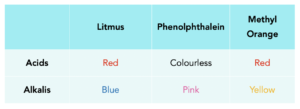Titrations (GCSE Chemistry)
Titrations
Carrying Out a Titration
Experimental Method
For exams, we need to describe how to carry out a titration. In the following example we will be looking at strong acids, such as sulfuric, hydrochloric and nitric acids.
- Gather your equipment. To carry out a titration you will need: a pipette, a pipette filler, a conical flask, a burette, a single indicator and the acid and alkali.
- Add alkali into the conical flask. You need to add a specific volume of alkali to the conical flask, such as 25cm3. To do this, you can use a pipette and a pipette filler.
- Add the single indicator into the conical flask. The indicator will change colour, due to the pH of the alkali.
- Fill the burette with acid. The acid will have a known concentration. In order to avoid any spillages, you need to place the burette below eye level when you fill it up. Whilst doing this, you should wear safety goggles and use a funnel.
- Record the initial volume of acid. Make sure to write down the initial volume of acid in the burette.
- Add the acid to the alkali. Add the acid to the alkali very slowly, using the burette to help you. Whilst you are adding the acid, make sure to swirl the conical flask so that the acid and alkali mix together.
- Slow down at the end point. When you think that the end point is near, make sure to add the acid very slowly to the alkali. The end point will be when the indicator changes colour, showing that the acid has neutralised the alkali.
- Record the final volume of acid. Now that the neutralisation has been completed, record the volume of acid remaining in the burette. This will allow you to calculate how much acid was added to the alkali during the reaction.
- Repeat the titration. Now that you have completed a ‘rough’ titration, you know where the approximate volume of acid required to neutralise the alkali in the conical flask. This time, you can be more precise when adding the acid, which will give a more accurate result.
- Take several readings. Keep repeating the experiment until you have results that show volumes of acid that are within 0.10cm3 of each other. Using these results, you can calculate a mean reading and exclude any anomalies from the experiment.
Using Titrations
Measuring Volumes of Acid and Alkali
- Titrations can measure volumes. By carrying out a titration experiment, we can find out the volume of alkali needed to neutralise a specific volume of acid. We can also find out the volume of acid needed to neutralise a specific volume of alkali.
- Indicators are used in titrations. When we carry out a titration, we need to use a single indicator. Unlike universal indicator, this type of indicator will show a sudden colour change when the experimental solution is neutralised.
- There are various single indicators. Some examples of single indicators that we can use in titrations are litmus, phenolphthalein and methyl orange. The table below shows the different colours of each indicator in acids and alkalis.

A titration is a laboratory technique used to determine the concentration of a solution by gradually adding a known concentration of another solution until a reaction is complete. This reaction is usually indicated by a color change or by reaching a set endpoint.
The purpose of a titration is to determine the concentration of an unknown solution by measuring the amount of a known solution required to react with it. This allows chemists to determine the precise concentration of a solution, which is important in many industrial processes and for quality control purposes.
A titration is typically performed in a laboratory by adding a known concentration of a solution (the titrant) to a flask containing the unknown solution (the analyte) using a burette. The titrant is gradually added to the analyte until a reaction is complete, which is indicated by a color change or by reaching a set endpoint. The volume of titrant required to complete the reaction is used to calculate the concentration of the analyte.
An indicator is a substance used in a titration to indicate the end of the reaction by showing a color change. Indicators are chosen based on their ability to change color at the endpoint of the reaction, which indicates that the reaction is complete and the desired concentration has been reached. Examples of indicators used in titrations include litmus paper and phenolphthalein.
An acidic titration involves a reaction between an acid and an alkali to neutralize each other, while an alkaline titration involves a reaction between an alkali and an acid to neutralize each other. The endpoint of an acidic titration is typically indicated by a change in color from red to pink or colorless, while the endpoint of an alkaline titration is typically indicated by a change in color from colorless to pink.
Titrations are widely used in the food industry for quality control purposes, to ensure that products such as fruit juice and vinegar contain the correct amount of acid. They are also used in the medical industry to determine the concentration of certain substances in the blood, such as glucose, and to monitor the effectiveness of treatments such as dialysis.
These questions and answers provide a comprehensive overview of titrations and their uses, making it easier for 15-16 year old students to understand the concept as they prepare for their GCSE chemistry exams.






Still got a question? Leave a comment
Leave a comment